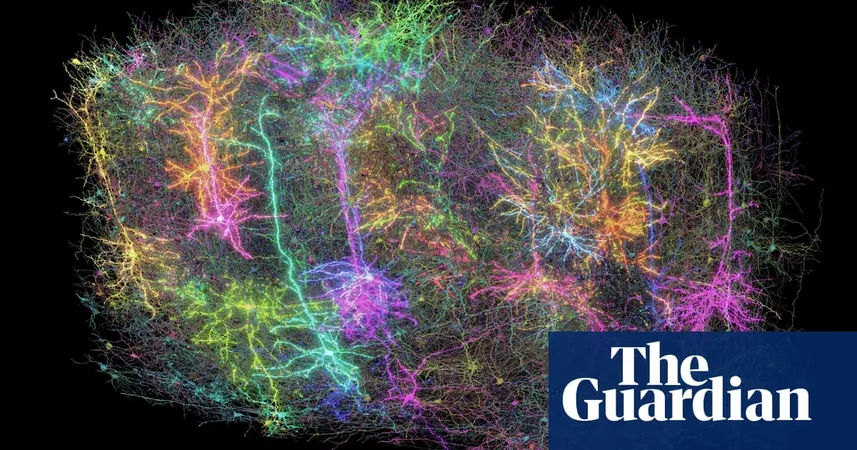
Groundbreaking Brain Map Reveals Secrets of Neural Connections
2025-04-09
Author: Liam
Revolutionizing Our Understanding of the Mammalian Brain
Scientists have achieved a remarkable milestone by creating the most detailed circuit diagram of a mammalian brain, unlocking secrets to how it operates. This transformative research focuses on a minuscule piece of a mouse's visual cortex, no larger than a grain of sand.
The newly crafted map traces the intricate connections of 84,000 neurons, interconnected by a staggering half a billion synapses and approximately 5.4 kilometers of neuronal wiring. This three-dimensional reconstruction of just one cubic millimeter of brain tissue is shedding light on the organization of the brain and how different cell types collaborate. Such insights could revolutionize our understanding of complex phenomena like intelligence and consciousness, as well as neurological disorders such as Alzheimer's, Parkinson's, autism, and schizophrenia.
A Watershed Moment for Neuroscience
Dr. David Markowitz, former manager at the U.S. Intelligence Advanced Research Projects Activity (IARPA), characterized these developments as a watershed moment for neuroscience, akin to the Human Genome Project in terms of its potential for transformative breakthroughs.
The ambitious MICrONS project aimed not just to map neuron structures but also to delve into their electrical signaling. This research has painted a clearer picture of the silent conversations occurring within the brain.
Innovative Techniques Unveil Brain's Hidden Architecture
Researchers at Baylor College of Medicine utilized advanced microscopes to monitor the brain activity of mice as they watched a variety of videos, including YouTube clips. Subsequently, teams from the Allen Institute sliced that tiny brain segment into over 25,000 ultra-thin layers, each 1/400th the thickness of a human hair, capturing high-resolution images using cutting-edge electron microscopes. Finally, Princeton University's team applied artificial intelligence and machine learning to piece together this wealth of data into a cohesive 3D model. The staggering dataset totals 1.6 petabytes, equal to 22 years of continuous HD video.
Uncovering New Insights and Cell Types
Dr. Clay Reid, a neurobiologist at the Allen Institute, illustrated the complexity of this tiny brain snippet, likening it to an intricate forest with established connection rules. The reconstruction not only validates existing theories but also opens doors to discoveries previously unimaginable.
The findings have revealed novel cell types and a groundbreaking understanding of inhibition in the brain. Historically, inhibitory cells were viewed as mere dampeners of neural activity, but this new research indicates they selectively target specific cells. This selective inhibition fosters a complex network of coordination and cooperation throughout the brain.
A Blueprint for Future Neuroscience Research
Gaining insights into the brain's structural and functional intricacies could significantly enhance our understanding of neurological disorders linked to disrupted neural communication. Dr. Nuno da Costa, an associate investigator at the Allen Institute, encapsulated the importance of this research by stating, "If you have a broken radio and you have the circuit diagram, you’ll be in a better position to fix it. We are creating a Google map, a blueprint of this grain of sand. This will enable us to compare healthy brain wiring in mice to that in models of disease in the future."









 Brasil (PT)
Brasil (PT)
 Canada (EN)
Canada (EN)
 Chile (ES)
Chile (ES)
 Česko (CS)
Česko (CS)
 대한민국 (KO)
대한민국 (KO)
 España (ES)
España (ES)
 France (FR)
France (FR)
 Hong Kong (EN)
Hong Kong (EN)
 Italia (IT)
Italia (IT)
 日本 (JA)
日本 (JA)
 Magyarország (HU)
Magyarország (HU)
 Norge (NO)
Norge (NO)
 Polska (PL)
Polska (PL)
 Schweiz (DE)
Schweiz (DE)
 Singapore (EN)
Singapore (EN)
 Sverige (SV)
Sverige (SV)
 Suomi (FI)
Suomi (FI)
 Türkiye (TR)
Türkiye (TR)
 الإمارات العربية المتحدة (AR)
الإمارات العربية المتحدة (AR)